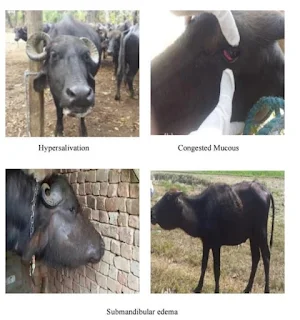Understanding Haemorrhagic Septicaemia in Livestock: Causes, Symptoms, Treatment, and Prevention
Introduction:
Haemorrhagic Septicaemia, also known as Septicaemic Pasteurellosis or Barbone disease, is a severe disease affecting livestock.
This blog post provides a comprehensive overview, covering its synonyms, introduction, etiology, epidemiology, pathogenesis, clinical signs, necropsy findings, diagnosis, treatment, and prevention.
I. Synonyms, Introduction, and Etiology:
- Synonyms: Septicaemic Pasteurellosis and Barbone disease.
- Introduction: Caused by Pasteurella multocida.
- Etiology: Types A to E linked to various diseases.
II. Epidemiology:
- Prevalence: Enzootic in tropical countries, economically significant in India.
- Outbreaks: Common in wet and humid weather.
- Morbidity and Fatality: Higher in buffaloes, with adult animals developing natural immunity.
III. Transmission and Host Affected:
- Transmission: Contaminated feed and water, ticks, and insect bites.
- Host Affected: Cattle, sheep, goats, yak, and water buffaloes highly susceptible. Horses and pigs less susceptible.
V. Pathogenesis:
- Entry: Organisms enter via tonsils, GI, and respiratory tracts.
- Circulation: Reaches heart, liver, and spleen, causing severe septicemia.
- Outcome: Often results in death within 24 hours; recovered animals develop immunity.
V. Clinical Signs:
- Symptoms: Acute septicaemic disease, fever, profuse salivation, sub-mucosal petechiation, depression, and warm, painful swellings.
- Respiratory Distress: Severe dyspnoea and enteritis in gastrointestinal form.
VI. Necropsy Findings:
- Hemorrhages: Generalized in serosa.
- Lungs: Edema, congestion, consolidation.
- Subcutaneous Area: Gelatinous fluid infiltration.
- Gastroenteritis: Haemorrhagic with thickening of interlobular septa.
VII. Diagnosis and Differential Diagnosis:
- Methods: Clinical signs, blood smear examination, culture isolation, and Elisa.
- Differential Diagnosis: Mycoplasmosis, chronic respiratory diseases, parasitic infection, pneumonic pasteurellosis.
VIII. Treatment:
- Antibiotics: Oxytetracycline, Sulphadimidine, Chloramphenicol, Ampicillin, Enrofloxacin, Ceftiofure.
- Anti-inflammatory: Betamethasone and Dexamethasone.
IX. Prevention and Control:
- Vaccine: Highly antigenic Pasteurella multocida strain, inactivated by formalin. Immunity lasts for about 6 months.
- Control Measures: Phenol treatment, vaccination before monsoon, stress avoidance.
Conclusion:
Understanding haemorrhagic septicaemia is crucial for livestock health.
This blog post has provided a comprehensive guide, covering its causes, symptoms, treatment, and prevention. By implementing effective control measures, including vaccination and stress reduction, farmers can protect their livestock from this economically significant disease.






Ask! Your doubt or Question.